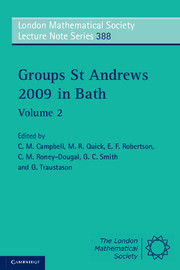Book contents
- Frontmatter
- Contents
- Introduction
- Algorithms for matrix groups
- Residual properties of 1-relator groups
- Words and groups
- The modular isomorphism problem for the groups of order 512
- Recent progress in the symmetric generation of groups
- Discriminating groups: a comprehensive overview
- Extending the Kegel Wielandt theorem through π-decomposable groups
- On the prime graph of a finite group
- Applications of Lie rings with finite cyclic grading
- Pronormal subgroups and transitivity of some subgroup properties
- On Engel and positive laws
- Maximal subgroups of odd index in finite groups with simple classical socle
- Some classic and nearly classic problems on varieties of groups
- Generalizations of the Sylow theorem
- Engel groups
- Lie methods in Engel groups
- On the degree of commutativity of p-groups of maximal class
- Class preserving automorphisms of finite p-groups: a survey
- Symmetric colorings of finite groups
- References
Pronormal subgroups and transitivity of some subgroup properties
Published online by Cambridge University Press: 05 July 2011
- Frontmatter
- Contents
- Introduction
- Algorithms for matrix groups
- Residual properties of 1-relator groups
- Words and groups
- The modular isomorphism problem for the groups of order 512
- Recent progress in the symmetric generation of groups
- Discriminating groups: a comprehensive overview
- Extending the Kegel Wielandt theorem through π-decomposable groups
- On the prime graph of a finite group
- Applications of Lie rings with finite cyclic grading
- Pronormal subgroups and transitivity of some subgroup properties
- On Engel and positive laws
- Maximal subgroups of odd index in finite groups with simple classical socle
- Some classic and nearly classic problems on varieties of groups
- Generalizations of the Sylow theorem
- Engel groups
- Lie methods in Engel groups
- On the degree of commutativity of p-groups of maximal class
- Class preserving automorphisms of finite p-groups: a survey
- Symmetric colorings of finite groups
- References
Summary
Abstract
A subgroup H of a group G is called pronormal in G if for each element g ∈ G the subgroups H and Hg are conjugate in 〈H, Hg〉. Pronormal subgroups have been introduced by P. Hall, and they play an important role in many studies dedicated to normal structure and Sylow theory of finite and infinite groups and in investigations of arrangement of subgroups in infinite linear groups over rings. Many interesting and important developments have been lately completed in this area by different authors. Thanks to these results, we can see that pronormal subgroups and some other types of subgroups related to them (such as contranormal, abnormal, polynormal, paranormal, permutable subgroups, and so on) are very closely connected to transitivity of some group properties (such as normality, permutability and other) and to (locally) nilpotency of a group. In the current survey, we try to reflect some important new results in this area.
Introduction
Recall that a subgroup H of a group G is called pronormal in G if for each element g ∈ G the subgroups H and Hg are conjugate in 〈H, Hg〉. Pronormal subgroups have been introduced by P. Hall. Important examples of pronormal subgroups are the Sylow p-subgroups of finite groups, the Sylow π-subgroups of finite soluble groups, the Carter subgroups of finite soluble groups and many others. Finite groups with all pronormal subgroups have been described by T.A. Peng in [41, 42].
- Type
- Chapter
- Information
- Groups St Andrews 2009 in Bath , pp. 448 - 460Publisher: Cambridge University PressPrint publication year: 2011

